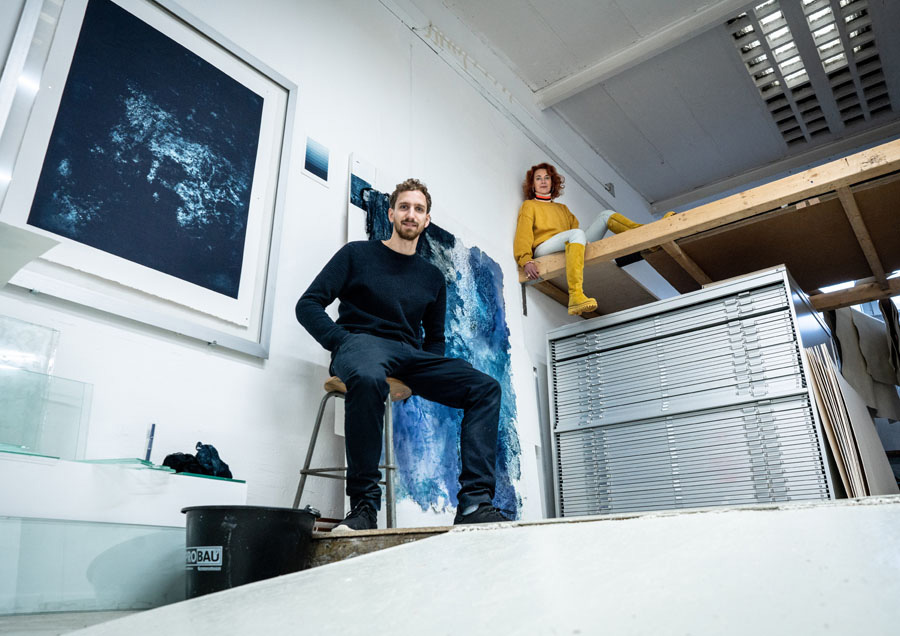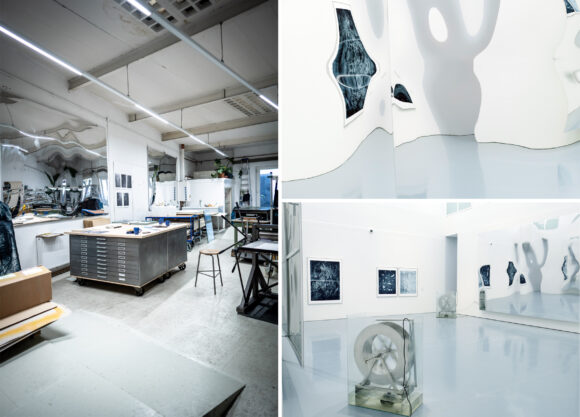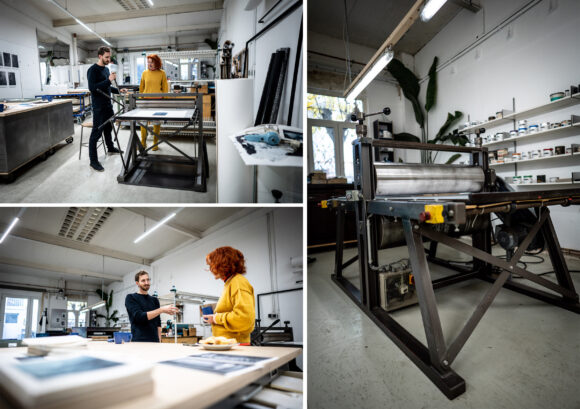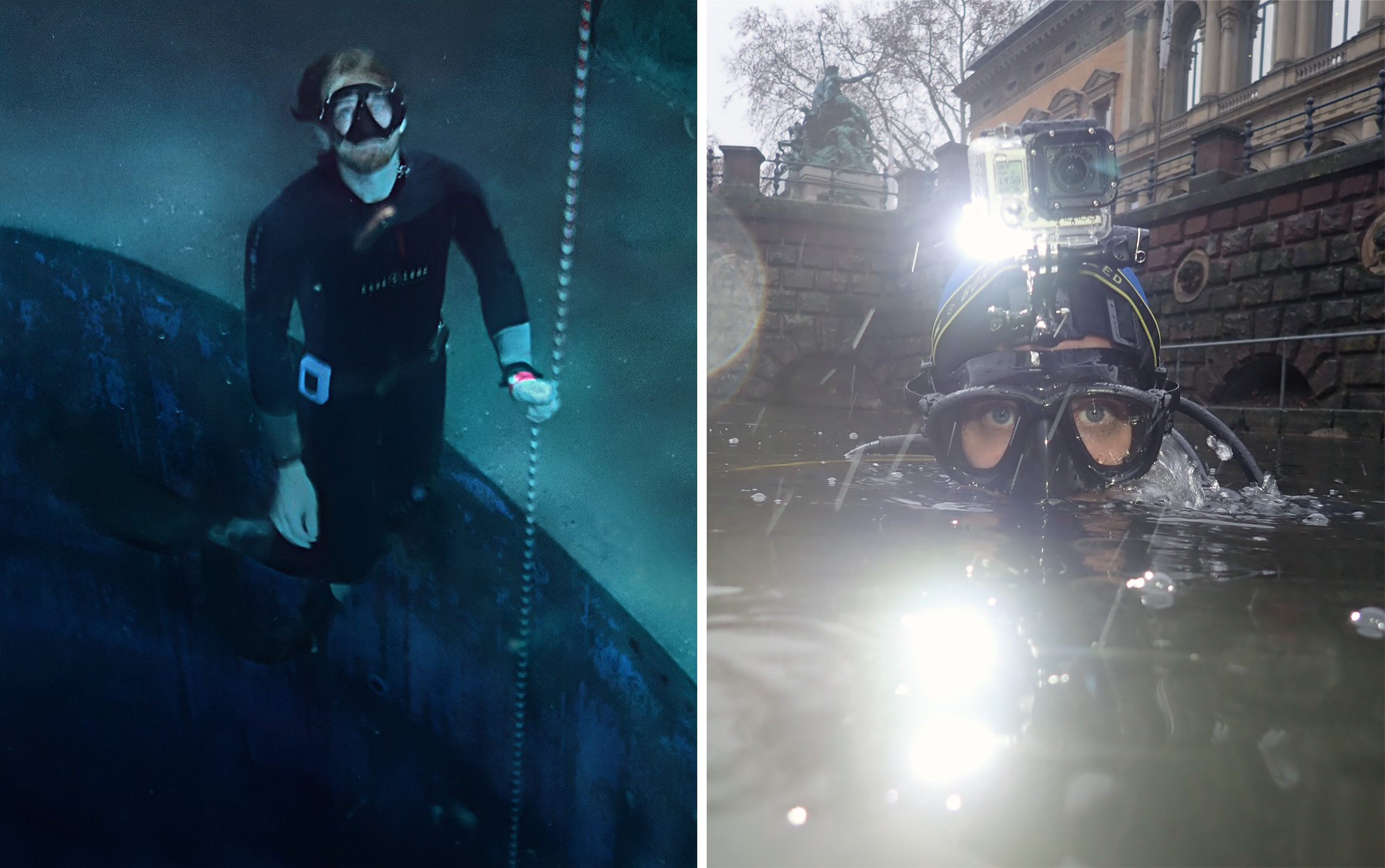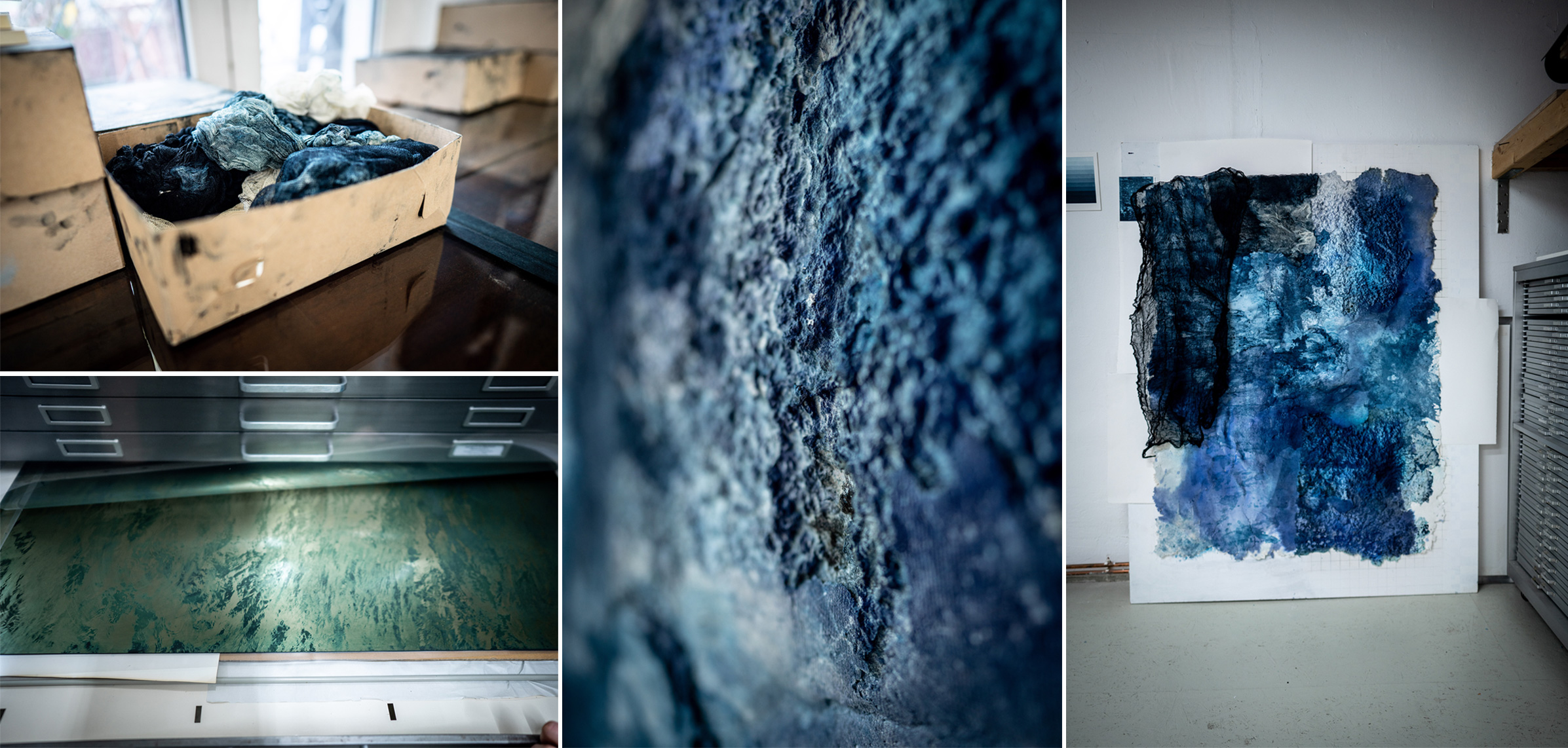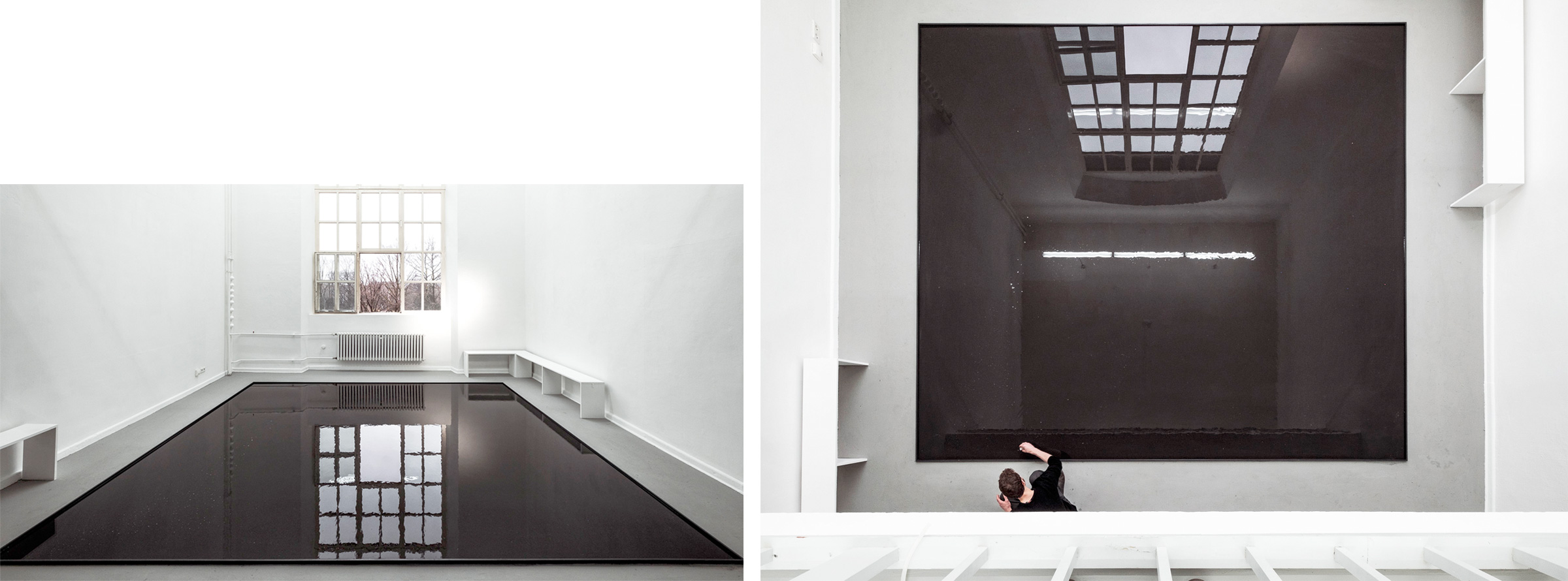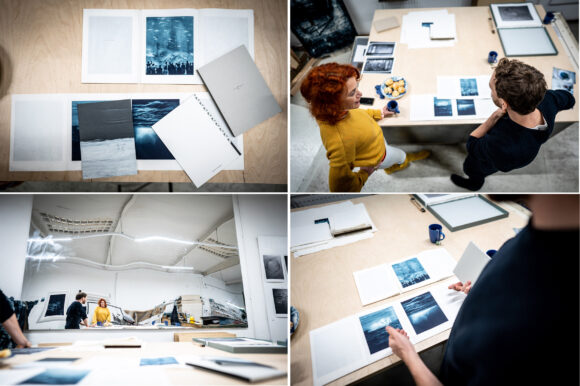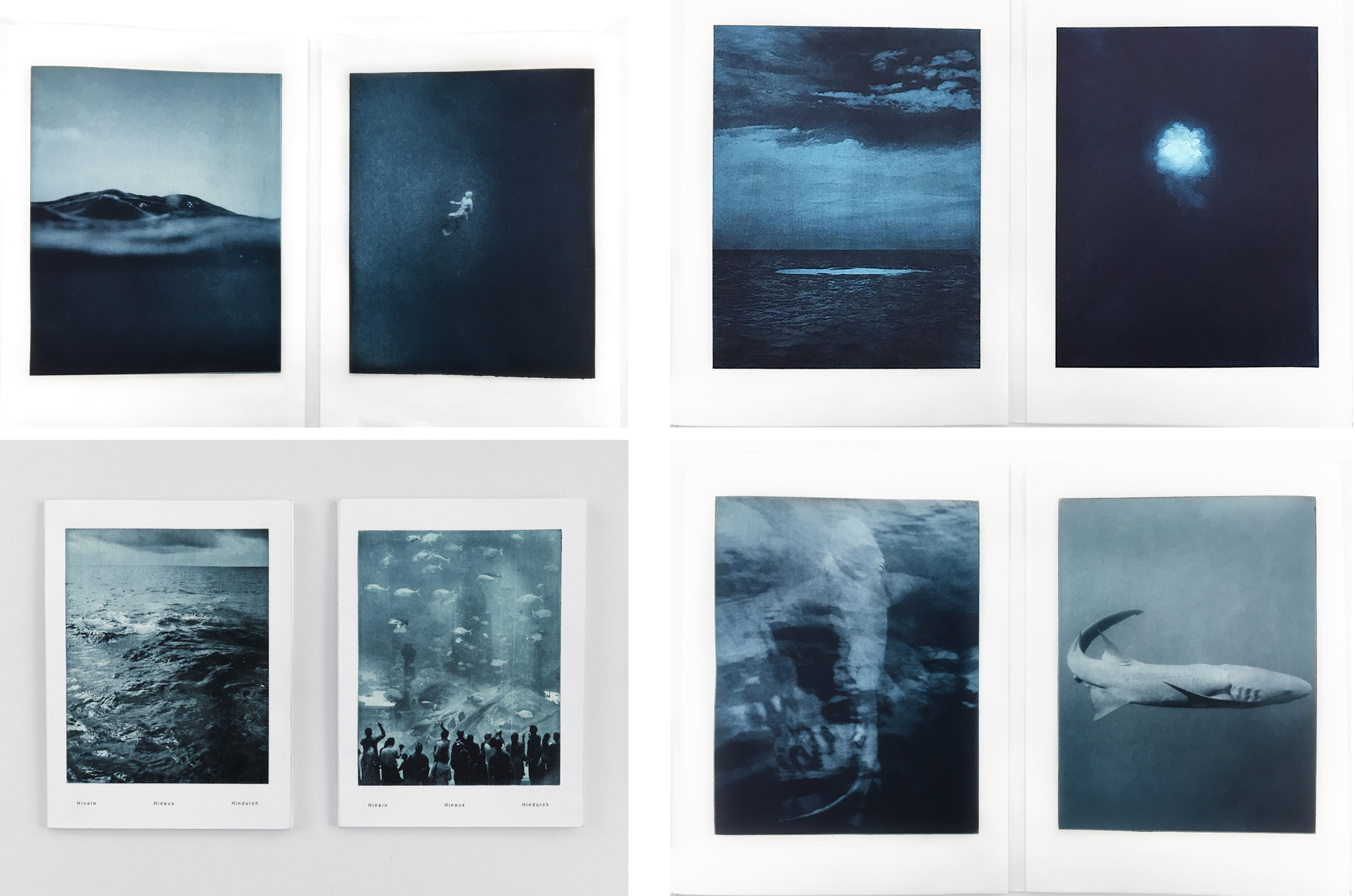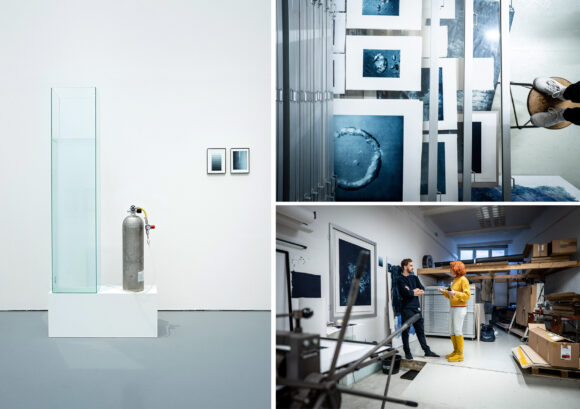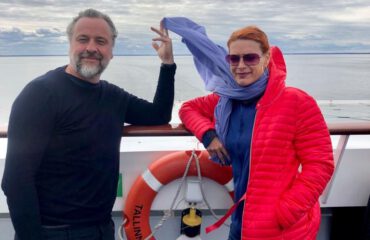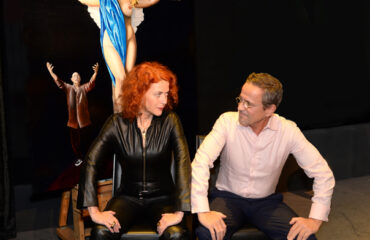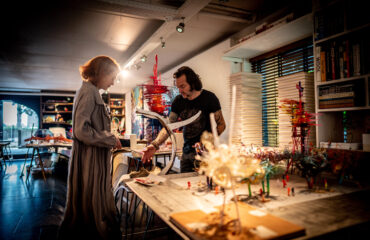Studio photos: Markus Schwer
Düsseldorf. Did I perhaps lose my way and end up in an adjacent print shop? Looking around the huge room filled with professional equipment rather than with art, I discover the large mirrors which I remember as part of the installation Irgendwo im Tiefenrausch in the Museum Kunstpalast in Düsseldorf. I am in the right place then. It is the studio of Aurel Dahlgrün.
Left: View into the studio, right: Installation views Irgendwo im Tiefenrausch (Museum Kunstpalast, Dusseldorf)
I am excited to meet the 2018 Ehrenhof prize winner, whose career has been proceeding at a breath taking pace since his graduation from the Düsseldorf Kunstakademie. His multifaceted work, which spans the media of photography, installation and art books, is already as much in demand by curators as by collectors. The presentation of this third art award was followed by numerous participations in group exhibitions in the Rhineland and in China, and particularly his first institutional solo exhibition linked to the Ehrenhof Prize (see images above).
Installation views of group exhibitions f. l. t. r.: Hinein – Hinaus – Hindurch (Sculpture Museum Changchun), Falling – Floating – Sinking (Filmwerkstatt Düsseldorf), Floating Circles (Kunstsammlung NRW)
A central theme can be recognized in all his works: Water. In today’s conversation, he explains this to me and particularly how he makes connections between this topic and the history of photography and its perception, simultaneously examining the effect of the images on the viewer and the exhibition space.
To warm up, we take a short walk around the studio and a first look at the technical equipment. During tea and bullar, baked personally by Aurel (!), I am approaching the complex subject by asking how this (obvious) fascination with water arose in the first place.
Introduction to the technical equipment
Aurel: That’s easy to answer. Although I was born in Berlin, I grew up in Sweden, directly on a lake. Fishing, diving, fish farming and aquaristics formed part of my everyday activities from an early age.
What were the pathways that took you from Sweden to Dusseldorf and the arts?
Aurel: At some stage, we moved back to Germany, where I, however, very quickly felt a longing for distant lands. At sixteen I moved in with a host family in São Paulo. After I matriculated I spent another year in Brazil before I moved to Dusseldorf. My path to art was laid out early. From childhood I spent many nights painting, and it was clear to me that I wanted to study art. However, when I applied to the academy I took my photography portfolio with me. I studied under Christopher Williams, with whom I travelled extensively internationally.
Is the focus there not mainly on theoretical and conceptual questions of photography? Did you not at some stage start to miss painting?
Aurel: I am essentially interested in questioning scientific approaches from the point of view of art. Because of the theoretical discourse in classes, the concept and the context always took centre stage. But because the practical work was also always very important to me, the history of photography enabled me to develop questions that were at the interface of theory and practice. I discovered such an interface in the field of reproduction techniques. Trying to answer the question what influence the printing process and the substrate have on the impact and the aura of the image, I tried out the most varied techniques and materials – at some stage, I even made my own paper. During this process I got the idea to shred my photographs and make new paper from the shreds. At some stage I became aware of two aspects: I had created a cycle, and, at the same time, something very beautiful – for instance, this picture [see picture bottom right].
Top left: Gauze to wipe the colour from the printing plates; bottom left: Example of a printing plate; centre: detail view of the picture composition; right: picture composition from shredded photo etchings of paper made by hand
Indeed. I would never have thought of photography when looking at this work. I remember his final presentation, the installation 19 weeks of water, which consisted only of a shallow basin filled with water, two benches and dehumidifier. Can a connection be seen here too? I pose the question.
Installation views 19 weeks of water (final presentation Kunstakademie Düsseldorf)
Aurel: Yes. Here too, a cycle was visualised, in this case under the aspect of the intake of various states of matter. During a period of 19 weeks, I had collected the moisture in the room and had then filled the basin with the condensed water. I considered this water as something like a photo emulsion. The objective was to create a mirror surface and diverse images, depending on the incidence of light and thus the movement in the room. To me, the mirror surface of the water is the archetypal reflection. The mirror as such significantly influenced the development of photography. The earliest optical instruments projected an image via an inverting mirror. Again, my reference to the history of photography.
Ah! I see. The function of the curved mirrors from the exhibition in the Museum Kunstpalast now also becomes accessible because surreal – distorted – pictures are also created here in the studio. On the table in front of one of the mirrors I discover Aurel’s beautiful artist’s book Hinein – Hinaus – Hindurch. There are two of them, each containing eighteen photoengravings, juxtapositions of aquaria motives viewed once from the inside and once from the outside, with changes of perspective from underneath and above the water. The books are printed on high-quality washi and are bound in an unusual way. Symmetrically folded, the pages may only be opened and looked at, if both hands open them at the same time. It is interesting to notice how the viewer hones in on the picture motives because of the unusual way of turning the pages.
Artist’s books Hinein – Hinaus – Hindurch
These motives show your passion for diving and aquaristics? How did you get the ideas for these juxtapositions?
Aurel: On the one hand, I have always been interested in the differences in the living environment of fish in their natural habitat and the artificially created one. On the other hand, I always found it interesting to watch people while they are looking at the water and in how many different ways the water changes our perception, depending on the circumstances of light and perspective. For instance, a diver will primarily perceive the vast depths, while a ship’s passenger will perceive the surface and thus the vastness of the water. I found this contrast between the surface and depth effect, but also of immediate presence and distance, very exciting. While I pursued this topic further, the idea grew in my mind to show the various patterns of perception on the basis of the juxtaposition, arranged in pairs, of motives connected to each other through change of perspective. It was interesting to find that during the work process, the similarities with the fundamental elements of photography increasingly revealed themselves: Focal length, incidence of light or the reversal of positive and negative. This became so intense that, when I dived, I had the feeling that I physically immersed myself in a negative [he laughs].
Examples of juxtapositions in the artist’s book Hinein – Hinaus – Hindurch
Talking about the body. When diving into the depth of water one is exposed to massive pressure fluctuations. Compressed air cylinders as well as the propulsion through pressure build-up often form part of your installations. Your photo engravings are also created via gravure print. Cycles and the water are visualised in your works in the most diverse forms. All in all, very metaphorical. Can one therefore perhaps speak of a symbolic projection of your own physical experiences and experiments around the topic of photography?
left: Installation view Airdrop (Museum Kunstpalast, Düsseldorf)
Aurel: Yes, indeed one can. I am mainly interested in the relationship between the body and the pictures. But in that process, I’m just acting as the medium. At the core is always the attempt to pursue questions which visualise the influence of pictures on our life and how they change the perception of our surroundings.
In conclusion, I ask myself whether Aurel Dahlgrün’s photography is, in fact, a means to an end. Within his artistic processes he disassembles it, decodes each of its parameters, literally immerses himself in it ……. And I become aware that it is not photography as such, which is the focus, but rather the experiments in connection with the extensive subject of the questions of image theory.
His work is even more exciting because the artistic results of his series of experiments are convincing not only from a content but also from an aesthetics point of view. It is perfectly obvious: Stay tuned!
